INTRODUCTION
In 2015 the Security Council held 245 meetings and adopted 64 resolutions and 26 presidential statements. It considered 45 agenda items, and went on 2 missions, one to the Americas and one to Africa. The Council also established three subsidiary bodies: the United Nations Electoral Observer Mission in Burundi (MENUB) which drew its operations to a close on 31 December 2015; the 2206 Security Council Committee on South Sudan and the OPCW-UN Joint Investigative Mechanism (JIM) in Syria. In December, the Council also decided that the 1267/1989 Al-Qaida Sanctions Committee should be renamed as the “1267/1989/2253 ISIL (Da’esh) and Al-Qaida Sanctions Committee”.
MEETINGS
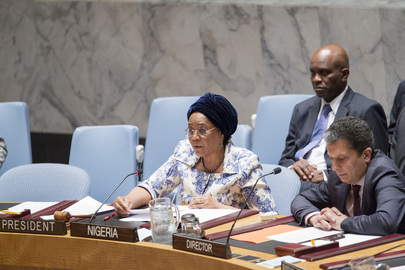
UN Photo/Rick BajornasSecurity Council Welcomes Signature of South Sudan Agreement (28 August 2015).
Meetings of the Security Council are governed by Article 28 of the United Nations Charter, and rules 1-5 and 48 of its provisional rules of procedure. Under its current practice, the Council convenes meetings, which are classified as either public or private. Council members also frequently meet in informal consultations of the whole (consultations).
Overview
In 2015, the Security Council held 245 meetings: 228 public meetings and 17 private meetings. With the exception of one meeting on the agenda item titled “Briefing by the President of the International Court of Justice”, all other private meetings were with police-and troop-contributing countries (P/TCCs). In addition to the 151 consultations held during 2015, the Council also considered 56 issues under “Other matters” (also known as “Any Other Business” (AOB)) which involved substantive briefings and/or discussions.
Chart 1: Number of meetings and consultations: 2011-2015
Meetings and consultations
In 2015, the Council held, on average, between 11 and 31 meetings per month, and between 9 and 16 consultations per month. December was the month with the most meetings and consultations held, with 31 meetings (29 public and 2 private) and 11 consultations.
Chart 2: Number of meetings and consultations by month in 2015
* “Other matters” refers to the 56 issues considered under “Other matters” which involved substantive briefings and/or discussions.
12
In 2015, the Council held 12 high-level meetings, in which 2 or more Council members were represented at the ministerial level or above [For details see Annex, Table I].
Chart 3: Number of high-level meetings: 2011-2015
85
The Council continued to utilize video tele-conferencing (VTC) for meetings and consultations, a practice that has become increasingly common since its introduction in 2009. In 2015, the Council was briefed by VTC 85 times.
Chart 4: Use of video tele-conferencing: 2011-2015
6 / 17
In 2015, Council members continued to hold informal interactive dialogues (IID), chaired by the President of the Council, and to use Arria formula meetings to informally exchange views with interested parties on specific topics. In 2015, the Council held 6 IIDs and 17 Arria formula meetings, the largest number of Arria formula meetings ever held by Council members in the course of a single year [For details see Annex, Tables II and III].
Chart 5: Number of informal interactive dialogues and Arria formula meetings: 2011-2015
Informal consultations of the whole
In 2015, Council members held 151 consultations on a variety of announced topics. In 56 instances, however, additional items were raised in consultations under “Other matters” leading to substantive briefings and/or substantive discussions on various situations. The most discussed topics in consultations during 2015 were the following: (i) Syria (32 times), (ii) Sudan/South Sudan (27 times); (iii) Yemen (19 times); (iv) Burundi (18 times) and (v) the Middle East (15 times). Below is an infographic of topics discussed at least [3] times in consultations in 2015.
Figure 1: Frequency of topics discussed in informal consultations of the whole in 2015
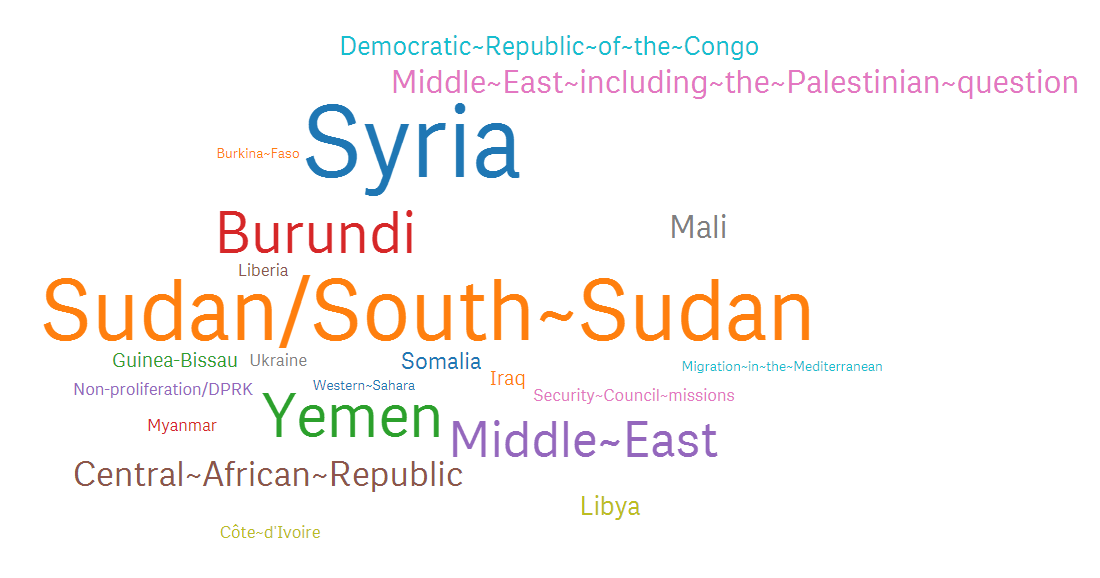
MISSIONS
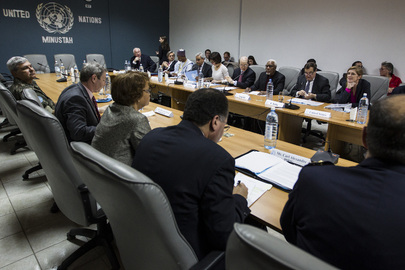
UN Photo/Logan AbassiSecurity Council Delegation Visits Haiti (23 January 2015).
In the presidential note of 26 July 2010 (S/2010/507), the Council underlined the value of its missions in order to understand and assess particular conflicts or situations on the agenda of the Council. Missions to the field have taken place since 1964.
Missions in 2015
In 2015, there were two Security Council missions. In January 2015, the Council dispatched a mission to Haiti (co-led by Chile and the United States). In March 2015, the Council went on mission to the Central African Republic (co-led by Angola and France), Addis Ababa (co-led by Angola and France) and Burundi (co-led by Angola, France and the United States).
Africa
March 2015
| Mission to | Co-Led By |
|---|---|
| Central African Republic | Angola and France |
| Addis Ababa | Angola and France |
| Burundi | Angola, France and the United States |
Chart 6: Number of Security Council missions by region 2011-2015
AGENDA
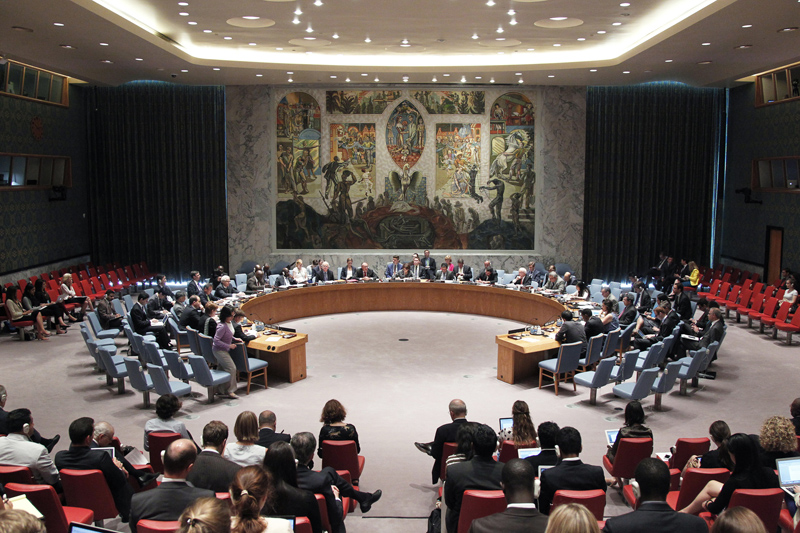
The Security Council Chamber during the daylong meeting (17 July 2014).
In accordance with rule 11 of the provisional rules of procedure and presidential note S/2010/507, every January, the Council reviews the list of matters of which it is seized. Agenda items which have not been considered at a Council meeting in the preceding three years are deleted unless a Member State objects. In the latter case, an item will remain on the list for an additional year, and will be subject to the same procedure described above if not considered.
Overview
In 2015, the Security Council considered a total of 45 agenda items; 26 dealt with country-specific or regional situations and 19 with thematic and other issues [For details, see Annex, Table IV]. In addition, 10 agenda items were deleted from the list of matters of which the Security Council is seized, and a total number of 68 agenda items were retained [For details, see Annex, Table V].
Chart 7: Percentage of meetings on country-specific/regional situations and thematic and other issues in 2015
Chart 8: Number of meetings held and resolutions/PRSTs adopted by agenda item in 2015
*Under Security Council resolution 1244 (1999)
Country-specific and Regional Situations
During 2015, 68% of the meetings (167) of the Council dealt with country-specific or regional situations. Among those meetings, Africa accounted for 53.9% (90) of the meetings, followed by the Middle East with 30.5% (51), Europe with 10.2% (17), Asia with 3.6% (6) and the Americas with 1.8% (3) [See Chart 9].
Chart 9: Percentage of meetings by geographic region in 2015
Thematic and Other Issues
In 2015, 32% of Council meetings (78) were held under agenda items of a thematic or “other” nature. The 7533rd meeting of the Council, under the thematic agenda item entitled “Women and peace and security”, became the meeting with the most speakers (113) in the Council’s history.
With regard to wrap-up sessions, the Council conducted such sessions at the end of the month in January, March, June, August and October, under the agenda item entitled “Implementation of the note by the President of the Security Council (S/2010/507)”. All five meetings were conducted as public sessions, and the wrap-up session held in August covered two months, July and August. At the October wrap-up session, following an open debate to consider its working methods, the Council issued a Statement by the President on the Council’s working methods (S/PRST/2015/19).
DECISIONS AND VOTING
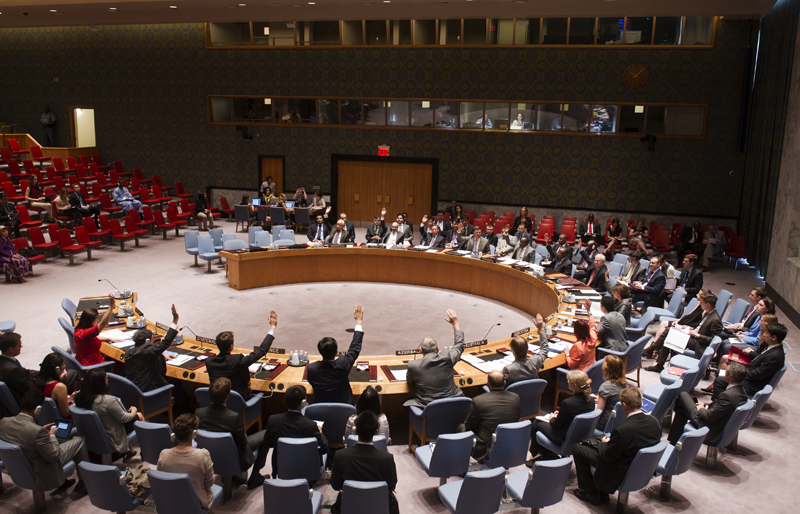
UN Photo/Mark GartenSecurity Council members voting to reaffirm arms embargoes on Somalia and Eritrea (24 July 2013).
According to Article 27, each Council member has one vote. An affirmative vote of nine members is required for decisions to be adopted on procedural and substantive matters, including in the latter case the concurrent votes of the permanent members. In addition to procedural decisions related to the adoption of the agenda, extension of invitations and adjournment of meetings, the Council adopts resolutions and issues presidential statements. Council decisions also take the form of notes and letters by the President of the Council.
Overview
In 2015, the Security Council adopted 64 resolutions (resolution 2196 (2015) to 2259 (2015)) and issued 26 presidential statements. During the year, the Council determined the existence of one new threat to international peace and security: the Islamic State in Iraq and the Levant (resolution 2249 (2015)). The Council also issued 13 notes and 36 letters by its President.
Chart 10: Number of resolutions, presidential statements, notes and letters by the President 2011-2015
Chart 11: Percentage of decisions by geographic region in 2015
In 2015, the Council also issued 128 press statements, of which 60% were in connection with terrorist-related activities, attacks against civilians or attacks against United Nations personnel in the field.
Figure 2: Frequency of countries discussed in press statements in 2015
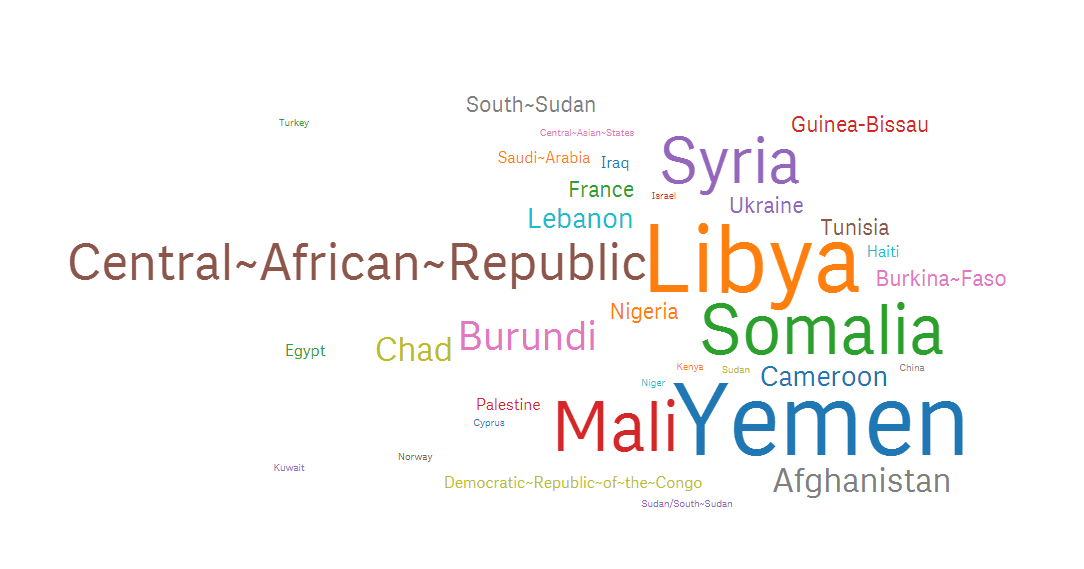
Voting
In 2015, the Council unanimously adopted 88% of its resolutions (56 out of 64). There were two cases of a veto (see below). There was also one procedural vote to adopt the provisional agenda on the item entitled “The situation in the Democratic People’s Republic of Korea”.
Chart 12: Voting on draft resolutions, 2010-2015
Draft resolutions not adopted in 2015
| Draft resolution | Meeting | Date | Agenda | Votes in favour | Vote Against | Abstensions |
|---|---|---|---|---|---|---|
| S/2015/508 | 7481 | 8-July-15 | The situation in Bosnia and Herzegovina |
10 (Chad, Chile, France, Jordan, Lithuania, Malaysia, New Zealand, Spain, United Kingdom, United States of America) |
1 (Russian Federation) |
4 (Angola, China, Nigeria, Venezuela (Bolivarian Republic of)) |
| S/2015/562 | 7498 | 29-July-15 | Letter dated 28 February 2014 from the Permanent Representative of Ukraine to the United Nations addressed to the President of the Security Council (S/2014/136) |
11 (Chad, Chile, France, Jordan, Lithuania, Malaysia, New Zealand, Nigeria, Spain, United Kingdom and United States of America) |
1 (Russian Federation) |
3 (Angola, China and Venezuela (Bolivarian Republic of)) |
Cross-Cutting issues in decisions of the Security Council
In 2015, the Council continued its practice of including provisions on cross-cutting issues, namely the Protection of Civilians (POC), Women and Peace and Security (WPS) and Children and Armed Conflict (CAAC), in its decisions relating to country-specific or regional situations. In 2015, 79% of resolutions and presidential statements relating to country-specific or regional situations contained one or more provision on POC, 59% on WPS and 48% on CAAC.
Chart 13: Number of decisions adopted under country-specific or regional situations with provisions on POC, WPS and CAAC
Resolutions under Chapter VII
In 2015, the Council adopted 35 out of 64 resolutions explicitly citing "acting under Chapter VII of the Charter", including 4 resolutions citing "acting under Article 41 of Chapter VII of the Charter" (one on the situation in South Sudan 2206 (2015), one on non-proliferation/DPRK 2207 (2015), and two on non-proliferation (Iran) 2224 (2015) and 2231 (2015) ), [For details see Annex, Table VI]. The majority of the 35 resolutions adopted under Chapter VII extended and modified mandates of peacekeeping operations and sanctions. By resolution 2206 (2015) of 3 March, the Council imposed a new sanctions regime consisting of a travel ban and an assets freeze on individuals and entities engaging in, or providing support for, actions or policies that threaten the peace, security or stability of South Sudan.
Chart 14: Resolutions adopted explicitly under Chapter VII of the Charter in 2015
SUBSIDIARY BODIES
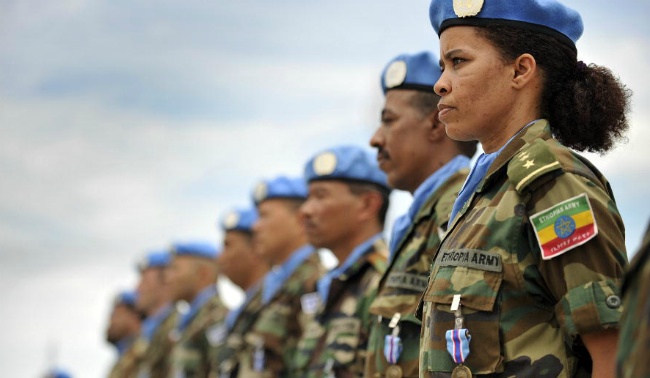
UN Photo/Christopher Herwig A Female Member of the Ethiopian Battalion of the United Nations Mission in Liberia (UNMIL) (August 2008).
UN peacekeeping operations, political missions and peacebuilding offices
In the course of 2015, the Council adopted decisions concerning the mandate of 13 peacekeeping operations (PKOs) (out of 16 that were in operation in 2015) and 5 political missions and peacebuilding offices (out of 11 that existed in 2015), primarily extending their mandates. The Council also established one new electoral observer mission (MENUB), which drew to a close on 31 December 2015, to follow and report on the electoral process in Burundi. Further, the Council established a joint OPCW-UN investigative mechanism to identify individuals, entities, groups or Governments involved in the use of chemical weapons in Syria.
Changes in Mandate
In 2015, several peacekeeping operations, political missions and peacebuilding offices underwent significant changes in their mandate. For more details see the comprehensive Mandate Table of current peacekeeping and political missions.
Changes in Authorized Strength
In 2015, three PKOs underwent revisions of their respective authorized ceiling of troop and/or police strength.
| PKO | Authorized Troops | Authorized Police | ||
|---|---|---|---|---|
| MINUSCA (Central African Republic) | +750 | S/RES/2212(2015) | +300 | S/RES/2212(2015) |
| UNMIL (Liberia) | -1221 -2350 | S/RES/2212(2015) S/RES/2239(2015) | -280 -909 | S/RES/2212(2015) S/RES/2239(2015) |
| UNMISS (South Sudan) | +500 | S/RES/2252(2015) | +678 | S/RES/2252(2015) |
Sanctions and other Committees and Working Groups
Committees met a cumulative number of 139 times in 2015, in both formal and informal formats, as well as in joint meetings. Eleven briefings to Member States were also conducted by Sanctions and other Committees.
Chart 15: Number of meetings per Sanctions and other Committees and Working Groups in 2015
Individuals and entities on Security Council sanctions lists
As of 31 December 2015, there were a total of 623 individuals and 398 entities designated for targeted sanctions measures such as assets freeze, travel ban and arms embargo, with 49 individuals and entities added in 2015. The chart below illustrates the number of listings for each Sanctions Committee as well as those added this year. Information on each Sanctions Committee, including individuals and entities designated by the committee and the applicable sanctions measures, as well as the procedures on submitting listing and delisting requests can be found on the Security Council Sanctions Committee website. A Consolidated United Nations Security Council Sanctions List is also available.
Chart 16: Number of individuals and entities listed as of 31 December 2015
De-listings from Security Council Sanctions Committees in 2015
In 2015, 77 individuals and entities were removed (de-listed) from the respective sanctions lists. De-listing requests from the Al-Qaida Sanctions List were submitted directly to the Al-Qaida Sanctions Committee or the Office of the Ombudsperson. De-listing requests from all other sanctions lists were submitted through the respective sanctions committees or the Office of the Focal Point for De-listing in the Secretariat. Any Member State can propose a name for de-listing. The Committee then considers the proposal, often in consultation with the designating state, and makes a final decision of whether or not to de-list. Often those proposing de-listings are the State of citizenship or residence of a listed individual, the State of location or place of registration of a listed entity, the designating State itself, or a Council member.
Chart 17: Number of names removed (de-listings from Security Council Sanctions Committees) in 2015
Focal Point for De-listing and Office of the Ombudsperson
In addition to Member States’ ability to de-list, two mechanisms have been established to strengthen the de-listing process. The Office of the Focal Point for De-listing, established in 2006, has received 85 requests, from 62 individuals and 38 entities. Eighty-two of these requests were processed by 31 December 2015. Of those processed, 56 listings were retained and 34 were de-listed. The Office of the Ombudsperson, established to serve as the de-listing mechanism for the Al-Qaida Sanctions Committee, has received 66 requests, since 2009, of which 61 were processed. Ten listings were retained and 47 were de-listed.
Chart 18: Activities of the Office of the Focal Point for De-listing as of the end of 2015
Chart 19: Activities of the Office of the Ombudsperson as of the end of 2015
Mandate extensions of Security Council subsidiary bodies
The chart below shows the number of Council resolutions extending the mandate of subsidiary bodies of the Council by month over the last 4 years [For details, see Annex, Table VII].
Chart 20: Mandate renewal by month: 2012-2015


